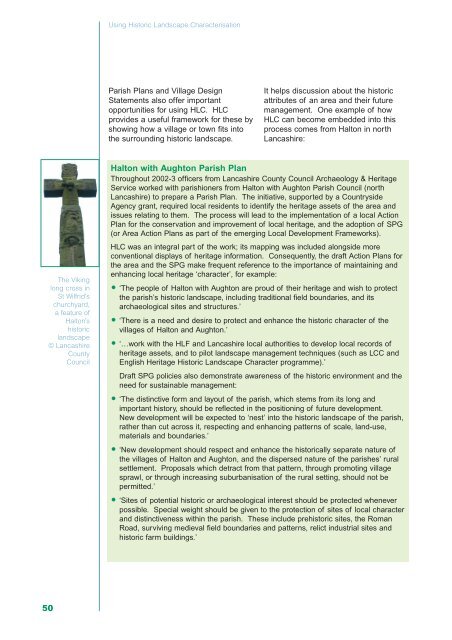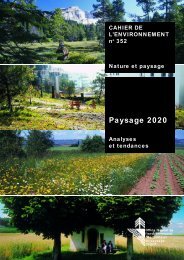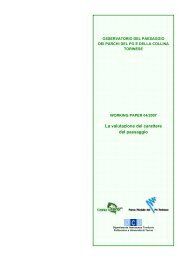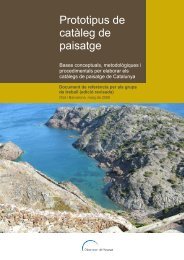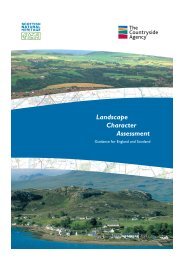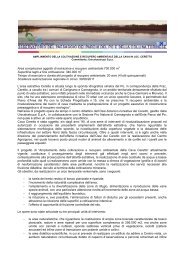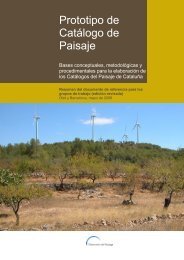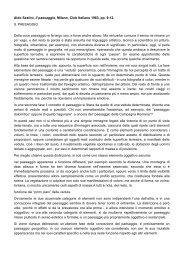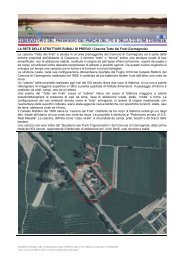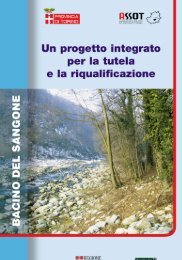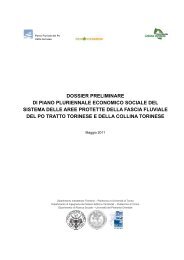Using Historic Landscape Characterisation
Using Historic Landscape Characterisation
Using Historic Landscape Characterisation
Create successful ePaper yourself
Turn your PDF publications into a flip-book with our unique Google optimized e-Paper software.
<strong>Using</strong> <strong>Historic</strong> <strong>Landscape</strong> <strong>Characterisation</strong><br />
Parish Plans and Village Design<br />
Statements also offer important<br />
opportunities for using HLC. HLC<br />
provides a useful framework for these by<br />
showing how a village or town fits into<br />
the surrounding historic landscape.<br />
It helps discussion about the historic<br />
attributes of an area and their future<br />
management. One example of how<br />
HLC can become embedded into this<br />
process comes from Halton in north<br />
Lancashire:<br />
The Viking<br />
long cross in<br />
St Wilfrid’s<br />
churchyard,<br />
a feature of<br />
Halton’s<br />
historic<br />
landscape<br />
© Lancashire<br />
County<br />
Council<br />
Halton with Aughton Parish Plan<br />
Throughout 2002-3 officers from Lancashire County Council Archaeology & Heritage<br />
Service worked with parishioners from Halton with Aughton Parish Council (north<br />
Lancashire) to prepare a Parish Plan. The initiative, supported by a Countryside<br />
Agency grant, required local residents to identify the heritage assets of the area and<br />
issues relating to them. The process will lead to the implementation of a local Action<br />
Plan for the conservation and improvement of local heritage, and the adoption of SPG<br />
(or Area Action Plans as part of the emerging Local Development Frameworks).<br />
HLC was an integral part of the work; its mapping was included alongside more<br />
conventional displays of heritage information. Consequently, the draft Action Plans for<br />
the area and the SPG make frequent reference to the importance of maintaining and<br />
enhancing local heritage ‘character’, for example:<br />
‘The people of Halton with Aughton are proud of their heritage and wish to protect<br />
the parish’s historic landscape, including traditional field boundaries, and its<br />
archaeological sites and structures.’<br />
‘There is a need and desire to protect and enhance the historic character of the<br />
villages of Halton and Aughton.’<br />
‘…work with the HLF and Lancashire local authorities to develop local records of<br />
heritage assets, and to pilot landscape management techniques (such as LCC and<br />
English Heritage <strong>Historic</strong> <strong>Landscape</strong> Character programme).’<br />
Draft SPG policies also demonstrate awareness of the historic environment and the<br />
need for sustainable management:<br />
‘The distinctive form and layout of the parish, which stems from its long and<br />
important history, should be reflected in the positioning of future development.<br />
New development will be expected to ‘nest’ into the historic landscape of the parish,<br />
rather than cut across it, respecting and enhancing patterns of scale, land-use,<br />
materials and boundaries.’<br />
‘New development should respect and enhance the historically separate nature of<br />
the villages of Halton and Aughton, and the dispersed nature of the parishes’ rural<br />
settlement. Proposals which detract from that pattern, through promoting village<br />
sprawl, or through increasing suburbanisation of the rural setting, should not be<br />
permitted.’<br />
‘Sites of potential historic or archaeological interest should be protected whenever<br />
possible. Special weight should be given to the protection of sites of local character<br />
and distinctiveness within the parish. These include prehistoric sites, the Roman<br />
Road, surviving medieval field boundaries and patterns, relict industrial sites and<br />
historic farm buildings.’<br />
50


